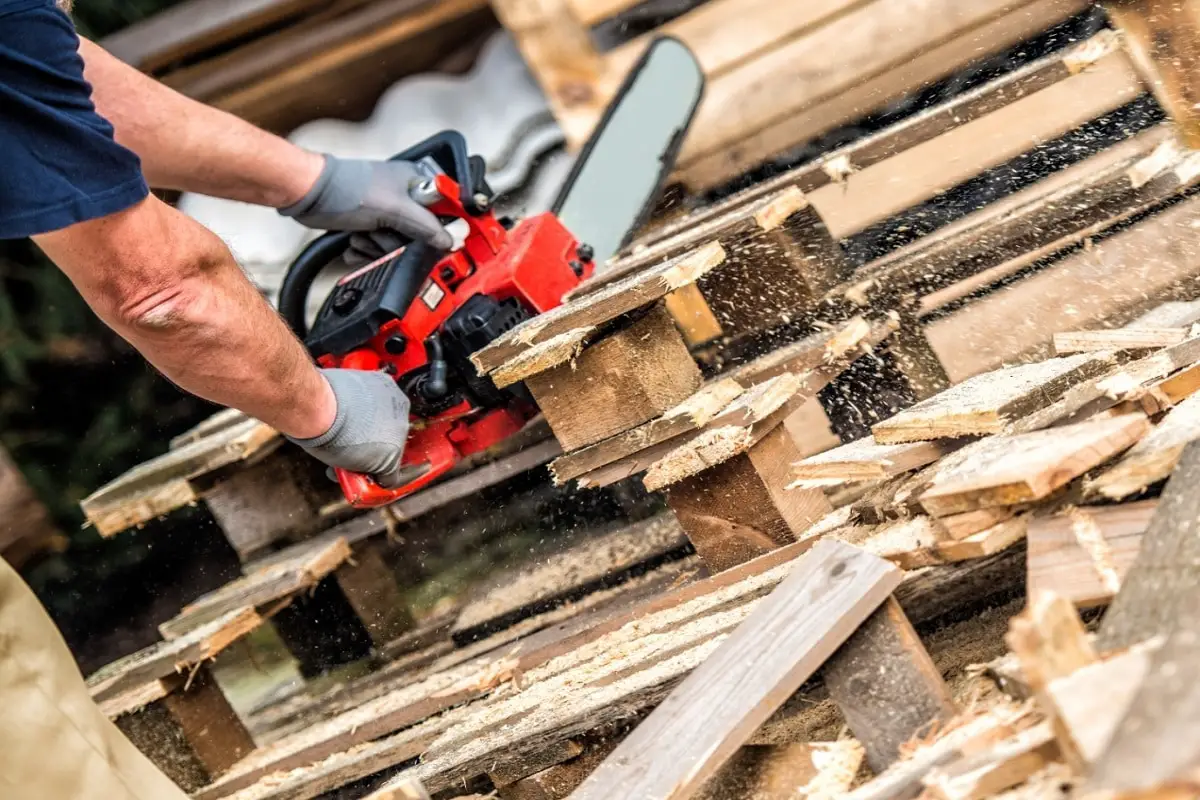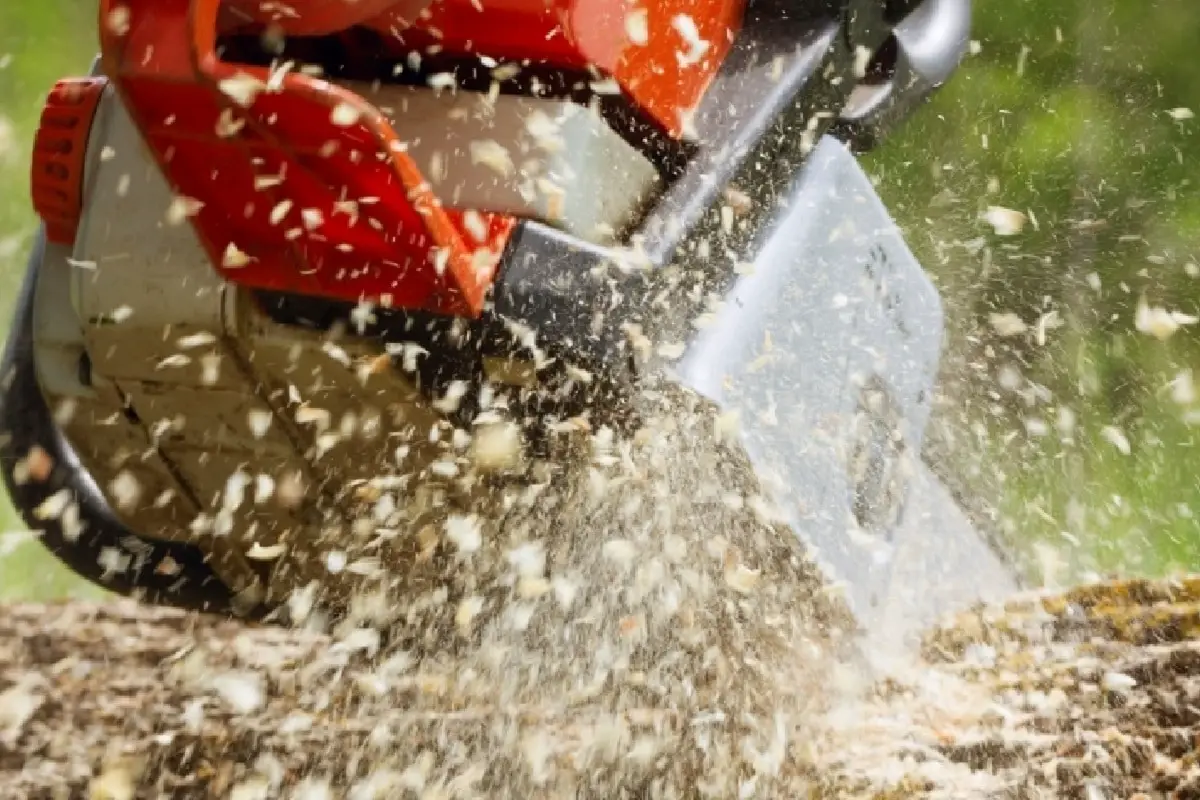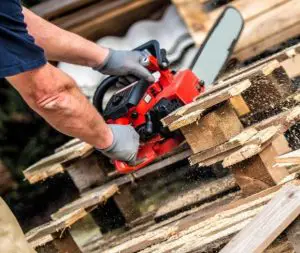Although many people think of a chainsaw as simply being able to cut wood, these machines are much more than that. Chainsaws are actually capable of cutting through a variety of different materials. This makes them great for completing cutting in different work environments quickly.
Chainsaws Are Designed for Cutting Wood
When people think of chainsaws, they usually think of sawing down trees or cutting lumber. With powerful engines and long sharp chains, chainsaws can safely cut heavy wood that would take a normal handsaw much longer to do. This saves time and money for lumber companies, forestry departments, arborists, gardeners and landowners.
Chainsaws are also great for cutting and trimming firewood, felling trees, clearing heavy brush and chopping up old lumber or pallets.
Will Nails In the Wood Break a Chainsaw or Its Chain?
A broken chain or stuck engine could be a possibility if you cut into a tree trunk that has nails or other metal in it. However, the most likely event is that the teeth on your chainsaw chain will become blunt very quickly and a potential unsafe kickback of the saw could happen.
If the nail or metal piece is very small or thin, the chainsaw may cut through it with no trouble but you can never be sure. The size and thickness of the metal being cut matters here.
Can Chainsaws Cut Through Metal?
Yes, chainsaws can cut through metal, but this depends on the type of metal and how thick it is. Only large powerful chainsaws should be used to cut metal, and the chain must be reinforced with diamond or carbide tips.
Instead of a chainsaw, use a metal cutting saw like this one used by rebar and rescue workers.
A reciprocating saw or circular saw with metal cutting blade are good choices for cutting lighter metal encountered when doing a job.
A regular chainsaw is not a good option for cutting metal. You should remove all nails or metal from the wood before cutting with one of these chainsaws. A regular wood chainsaw, either electric or gas-powered, will not have a powerful enough motor or the right chain to cut through metal or break nails. Hitting big pieces of metal could cause serious kickback or a broken chain.
If you do decide to cut through materials with embedded metal with a chainsaw, make sure to have the right-sized chainsaw and a chain that is metallic or diamond reinforced.

Here are some highly-rated electric wood chainsaws if you’re in the market for one:
Oregon CS1500 18-inch Self-Sharpening Corded Electric Chainsaw – 15 Amp 120 Volt
Greenworks 12-inch Cordless Chainsaw – 40 Volts with 2 Ah Battery and Charger
As an Amazon Associate, SelectSafety earns commissions from qualifying purchases made through links in this post.
Can Chainsaws Cut Through Plastic?
Yes. Chainsaws do a good job of cutting through most plastics. The types of plastic these chains can cut include:
- Polyethylene
- Acrylic sheets
- Plexiglas
- Lexan
- Polypropylene
- Polycarbonate
- PVC
What is needed is a ripping saw chain designed for cutting plastics such as polyethylene. These types of chains fit a range of chainsaw bar lengths ranging from 15″ and 25″.
Chains that are made for cutting plastic are labelled as “non-melt plastic cutting saw blades” and are often carbide tipped.
Of course, you will have to change out your standard wood cutting chain with a ripping saw chain to make cutting plastic safe. There is also a specific type of chainsaw designed for cutting plastic, called a pneumatic chain saw.
A common issue with cutting plastic is chip-welding, or the melting of the plastic while cutting. Special plastic cutting saw blades have teeth with negative hook angles and sizes that minimize blade heat while cutting. This makes the cut edge square and smooth.
Can Chainsaws Cut Through Pipe?
Yes and no.
A normal wood chainsaw will easily go through PVC or rubber water pipe, but not metal pipe.
Normal chainsaws designed for wood will not safely cut through metal pipe.
A concrete chain saw like this one can cut through most smaller metal pipe along with concrete. If the pipe is buried in concrete, underneath concrete, or inside a wall, the concrete chainsaw will be able to cut it. Pneumatic concrete chain saws are designed to be able to cut ductile iron which is what underground pipes are made of.
Can Chainsaws Cut Through Drywall?
Regular chainsaws and concrete chainsaws can cut through drywall, however, if the drywall is covering a wall with metal wiring or pipe inside, this could pose a problem. Concrete chainsaws are ideal for this type of cutting because they can cut the most difficult materials. Cutting drywall all by itself with a chainsaw might be overkill and create a lot of extra drywall dust in the air. A Sawzall (reciprocating saw) is a better choice for cutting drywall.
Can Chainsaws Cut Through Flooring?
Chainsaws of all sizes are capable of cutting through flooring, however this could pose a problem if plastic or metal is embedded in it. Instead, consider using a reciprocating saw with a metal cutting blade or more powerful professional grade chainsaw with metal or concrete cutting chains.
Can Chainsaws Cut Roofing?
Yes, but the chainsaw risks cutting into old nails, or wiring, or metal braces that could break the chain. The right chain could help, but so could using a circulating saw or large professional chain saw with the right chain.
Can Chainsaws Cut Glass?
Yes, but it is not recommended. This could cause significant splintering and shards breaking off which is very dangerous. At best, a chainsaw may be useful to puncture a window in order to break into your house if you have been locked out of it on accident. But if you do this, do not have the chainsaw running as it is not necessary and can lead to injury. If you are thinking of cutting glass, consider a circular saw or a special glass cutting saw.
Can Chainsaws Cut Meat and Bone?
A larger chainsaw can definitely cut meat and bone, such as after a successful hunt or on the ranch. In fact, the original chainsaw was designed to cut flesh and bone to help women during pregnancy! Meat cutting in the beef industry is usually done by special band saws or rotary saws attached to robot arms.
Concrete Chain Saws = Less Kickback
Concrete chain saws like this one from Husqvarna can cut concrete, brick, tile, rebar, flooring, walls. One benefit to concrete chain saws is that they use diamond-studded chains which do not cut as much as they grind through the concrete. This means there is less chance of kickback than with a standard chainsaw. So, a large and powerful concrete chainsaw could actually be safer to use than a much smaller general-purpose chainsaw that is used to cut wood.
Of course, the main reason why these materials chainsaws can cut through various materials is that they have blades that are able to cut through a variety of different materials. Regardless of what material you are cutting with a chainsaw, the important thing to remember is safety which should remain always on your mind while using one.
Safest Materials For Chainsaws To Cut

Standard chainsaws can cut a variety of materials but are safest at cutting wood, trees, branches and firewood.
Chainsaws designed for more specialized jobs can also cut metal, plastic, concrete, frozen meat and bone safely.
No material is completely safe when cutting with a chainsaw, as chainsaws are inherently dangerous and there are lots of surprises when cutting into unknown things. Particles and shards can fly off the cutting area which can impact the eyes, lungs and skin.
Always wear the right mesh-type face shield and PPE when using a chainsaw, no matter what you are cutting.
Engine Power and Chain Type Impact What a Chainsaw Can Cut
The power of the engine (or electric motor) and the type and length of chainsaw chain will determine what materials your chainsaw can cut. Certain chainsaws are optimized for cutting certain materials over others.
For instance, small chainsaws for home use can only be used to cut wood, branches and firewood.
Concrete cutting chainsaws and pneumatic chainsaws can cut a much wider variety of materials, including concrete, metal, and plastic.
Overall, a more powerful chainsaw will be able to cut harder materials and larger pieces, and have fewer problems when it encounters hard objects like nails or metal pieces.
NEXT UP: Ouch! Top 5 Chainsaw Injuries (+ How To Avoid Them)

